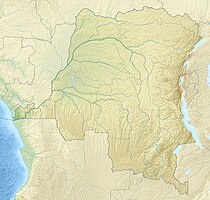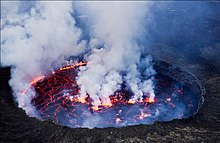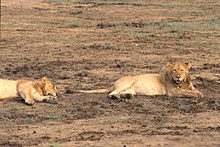Virunga National Park
|
Virunga National Park
|
||
|
Gorilla in Virunga National Park |
||
| location | North Kivu , Democratic Republic of the Congo | |
| surface | 7835 km² | |
| WDPA ID | 166889 | |
| Geographical location | 0 ° 24 ′ S , 29 ° 30 ′ E | |
|
|
||
| Setup date | 1925 | |
| administration | Congolais Institute for the Conservation of Nature (ICCN) | |
| particularities | oldest national park in Africa | |
| Virunga National Park | |
|---|---|
|
UNESCO world heritage |
|
| National territory: |
|
| Type: | nature |
| Criteria : | (vii) (viii) (x) |
| Surface: | 800,000 ha |
| Reference No .: | 63 |
| UNESCO region : | Africa |
| History of enrollment | |
| Enrollment: | 1979 ( session 3 ) |
| Red list : | since 1994 |
The Virunga National Park ( French Parc national des Virunga ) is a 7835 km² national park in the northeast of the Democratic Republic of the Congo on the border with Rwanda and Uganda . Like the Volcano National Park in Rwanda, the Virunga National Park was created in 1969 from the division of the Albert National Park, which had been in existence since 1925. It is Africa's oldest national park. Due to the great height differences, flora and fauna in the national park are very diverse. The Virunga National Park is best known for the mountain gorillas that occur here .
geography
The oldest national park in Africa, founded in 1925 , is located directly east of the great Central African Threshold and mostly in the elongated Great Rift Valley . It extends up to 300 km in length and 150 km in width from Lake Kiwu over the Virunga volcanoes and Lake Eduard to the rift valley area north of the snow-covered Ruwenzori Mountains . The park stretches from the plains in the north (798 m) to the mountains, including Margherita Peak with a height of 5,109 m. The annual precipitation varies from 500 mm at the Albertsee to 3000 mm in the moon mountains .
The Virunga National Park borders on a length of about 50 km with the Volcano National Park in Rwanda, on about 45 kilometers on the Rwenzori Mountains National Park and on a few kilometers on the Mgahinga Gorilla National Park , the latter both in Uganda. Due to the common borders, the four parks form a coherent protected area.
history
Albert National Park
The predecessor of the Virunga National Park, the Albert National Park, was established in 1925 and was the first national park in Africa. Initially, only a small area around Karisimbi, Visoke and Mikeno was declared a national park in order to protect the gorillas living here from poaching. As early as 1929, the colonial power Belgium expanded the park to include additional areas in Rwanda-Urundi and the Belgian Congo . The park grew to an area of 8090 km².
Division and state of war
After the independence of the Congo, Albert National Park was divided in 1969. The Volcano National Park in Rwanda and the Virunga National Park in the DR Congo were created. Since 1979, the National Park World Heritage of UNESCO . The park includes one of the regions with the greatest biodiversity in Africa. Since 1994 it has been on the Red List of World Heritage in Danger . The reason for this was the huge wave of refugees that pushed into the region after the genocide in Rwanda . The need for firewood and food of nearly one million people who sought refuge in camps within the park threatened the very existence of the park as a whole. During this time, more than 600 tons of wood were felled each day and over 9,000 hippos were slaughtered. In the plains, the refugees cleared land for settlements and agriculture. Some of the soldiers posted for protection took part in poaching themselves. The mountain gorillas were largely spared from the unrest, as their habitat is mainly high on the mountain slopes.
It is estimated that there are still 90,000 settlers in the park area today. Several armed groups have been operating there since the end of the Second Congo War , and the Congolese army once again deployed up to four brigades in the region to fight them. Even after the official end of the war in 2002, armed clashes continue to take place.
After several fatal incidents and kidnappings, Virunga National Park was closed to tourists on June 4, 2018. When the park reopened in February 2019, the violence against the rangers continued. By March 2019, over 170 of the park's 700 rangers died . In late April 2020, up to 18 people, including about a dozen rangers, were shot dead in an attack on a convoy near the park administration center in Rumangabo. According to the Congolese nature conservation authority ICCN , the attack came from the rebel group FDLR . The militia finances its activities, among other things, through the illegal charcoal trade.
Flora and fauna

The vegetation varies from afro-alpine, almost bare areas to gallery forests . There are extensive grass areas, tree savannahs, in places also lava fields and equatorial rainforest . The lakes within the national park serve as permanent watering places for the animals.
Most famous are the very rare mountain gorillas that live in the park . Despite the civil war and waves of refugees, the population remained largely stable between 1994 and 2004. In addition to the mountain gorillas, there are other rare animal species in the park. The first okapi was discovered here in 1901 . In 2006, for the first time since 1959, okapi tracks were seen in the park; Furthermore, an unknown number of forest elephants still live in the park; they wander between Uganda, the Kahuzi-Biega and the Virunga National Park. There are also giraffes , various buffalos and several endemic bird species.
In addition to these rarities, 22 other large mammal species (> 20 kg) live in the park. These include typical species of the Central African rainforests, such as chimpanzees , bongos , yellow-backed ducks , black-backed ducks , giant forest hogs and brush-eared hogs , but also real savannah animals such as lions , hyenas , topi , waterbuck , Uganda antelope , common reedbuck , warthog , anubi baboon and porcupine baboon . In addition, there are also adaptable species such as leopard, bushbuck and bush pig that colonize a wide variety of habitats. The Sitatunga antelope inhabits the marshland of the park.
Poaching and Conservation
The rangers in the national park became involved in the political conflict in the region. An employee of the Frankfurt Zoological Society (ZGF) reported that the rebels had refused any dialogue with the ICCN national park rangers and began to attack their posts. Despite the fact that more than 100 rangers were killed on duty in the course of the civil war and the payment was very irregular, the rangers in Virunga National Park are committed and convinced of their cause. The threat to the rangers increased massively from 2006 onwards. At that time, the rangers demanded cooperation with the UN peacekeeping forces on site.
In 2006, the FZS trained 480 rangers in Virunga with financial support from the EU, UNESCO and the US Fish and Wildlife Service . But these rangers face poachers in a ratio of 5: 1, some of whom are armed with machine guns and bazookas. The rangers are generally poorly supplied with equipment and food and are paid irregularly. 150 of them have died in the meantime (at the end of 2012). In most of the national park concessions for oil have been issued. The British company Soco International is one of the companies that have received concessions. Although local laws prohibit environmentally harmful activities in protected areas, Soco's exploration permit used an exemption for "scientific" activities. Due to public pressure, Soco International stopped its activities in the national park in 2014.
literature
- Wally and Horst Hagen: The African national parks as habitats for elephants . In: Vitus B. Dröscher : Save the elephants of Africa . 1st edition. Goldmann Verlag , Munich 1992, ISBN 3-442-12322-4 . P. 252.
Movie
The documentary Virunga (2014) describes the dispute between the supporters and protectors of the national park and the British oil company SOCO, which wants to probe for oil in the area of the park.
Web links
- Official Homepage of the National Park (English)
- Entry on the UNESCO World Heritage Center website ( English and French ).
- Justification of the WHC for the entry into the Red List (English)
- Status report 2006 (English; PDF; 742 kB)
- National park map
- Interview with park manager Ephrem Balole, December 17th, 2012, Rettet den Regenwald eV
- Spektrum .de: Africa's crown jewel in danger February 23, 2019
- Simone Schlindwein: National park against human rights: farmers, bombs and mountain gorillas. In: The daily newspaper . 11th July 2019 .
Individual evidence
- ↑ Virunga National Park - World Natural Heritage in the heart of Africa. WWF Germany , accessed June 30, 2016 .
- ^ Philip Briggs & Janice Booth (2001) Rwanda: The Bradt Travel Guide p171. Bradt Travel Guides Ltd. and The Globe Pequot Press Inc. ISBN 1-84162-034-3
- ↑ UNESCO World Heritage Center: Virunga National Park. Retrieved August 20, 2017 .
- ↑ Juliane von Mittelstaedt: The treasure of Virunga. Congo. In: Der Spiegel. Rudolf Augstein , April 19, 2014, archived from the original on August 5, 2014 ; accessed on March 27, 2015 .
- ↑ Virunga National Park: Tourism break after kidnapping. In: Deutschlandfunk . June 4, 2018, accessed June 4, 2018 .
- ↑ a b Ranger killed weeks after reopening of Virunga national park. In: The Guardian . March 8, 2019, accessed April 27, 2020 .
- ↑ a b c massacre of gorilla protectors. In: The daily newspaper . April 26, 2020, accessed April 27, 2020 .
- ↑ Abdi Latif Dahir: 12 Rangers Among 17 Killed in Congo Park Ambush . In: The New York Times . April 25, 2020, ISSN 0362-4331 ( nytimes.com [accessed May 6, 2020]).
- ↑ WWF, Rare Okapi Sighted in Eastern Congo Park, June 8, 2006
- ↑ Photo Reveals Rare Okapi Survives Poaching Onslaught, September 10, 2008
- ↑ Information sheet on the Virunga National Park. In: Protected Areas and World Heritage. UNEP, July 2002, archived from the original on October 12, 2008 ; accessed on March 27, 2015 (English).
- ↑ John C. Morrison, Wes Sechrest, Eric Dinerstein, David S. Wilcove, and John F. Lamoreux: Persistence of Large Mammal Faunas as Indicators of Global Human Impacts. Journal of Mammalogy , 88 (6): 1363-1380, 2007.
- ↑ a b John Vidal: Congo's rare mountain gorillas could become victims of oil exploration. Endangered species. In: The Guardian . Guardian News & Media Ltd., August 1, 2013, accessed March 27, 2015 .
- ↑ The economic importance of the Virunga National Park. (PDF) WWF , August 15, 2013, p. 9 , accessed June 30, 2016 .
- ↑ Avoided: No oil drilling in Virunga National Park! WWF Germany , June 11, 2014, accessed June 30, 2016 .




